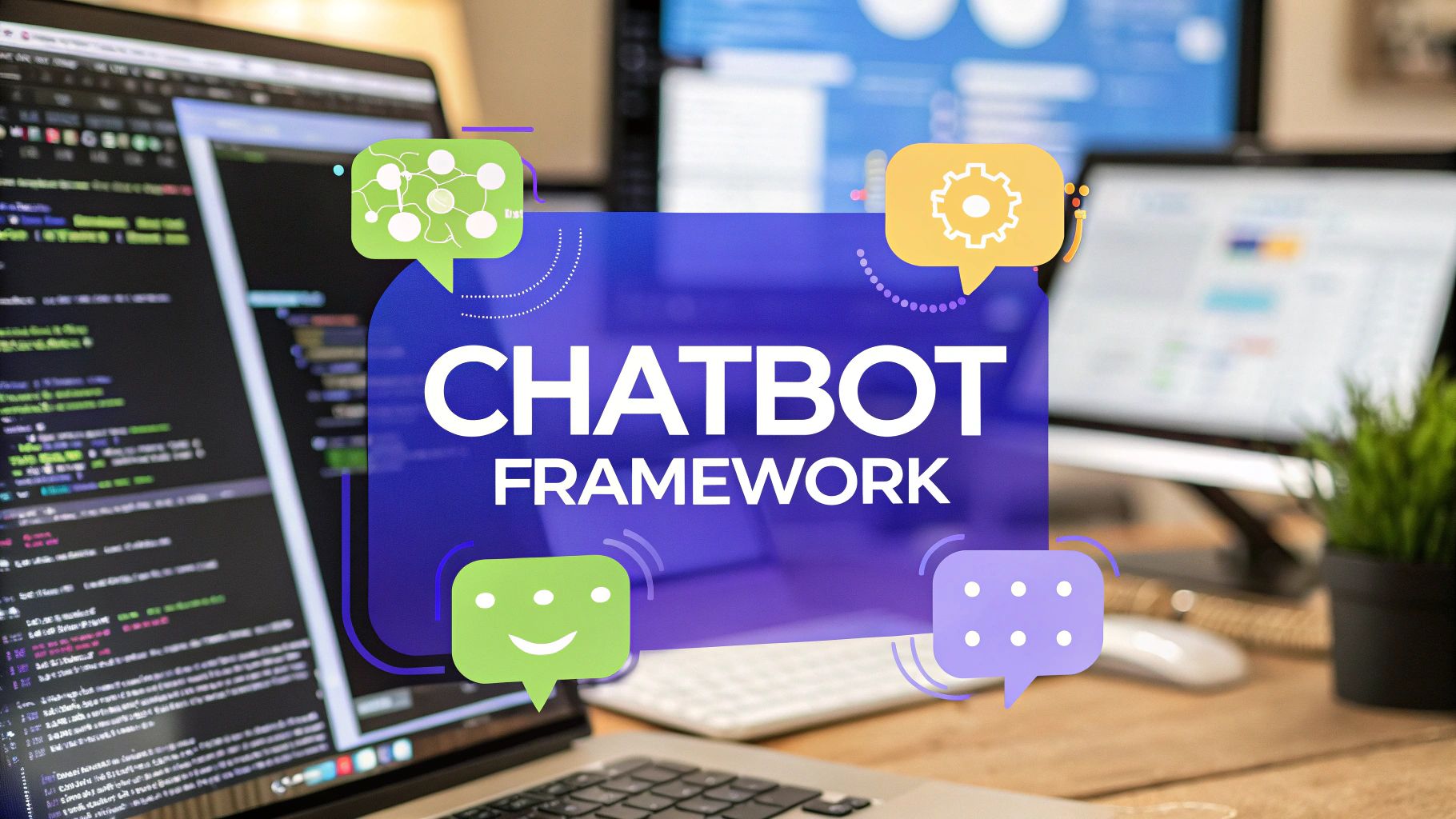9 Essential Chatbot Best Practices for 2025
Unlock the power of conversational AI. Explore 9 essential chatbot best practices for design, implementation, and optimization with Chatiant.
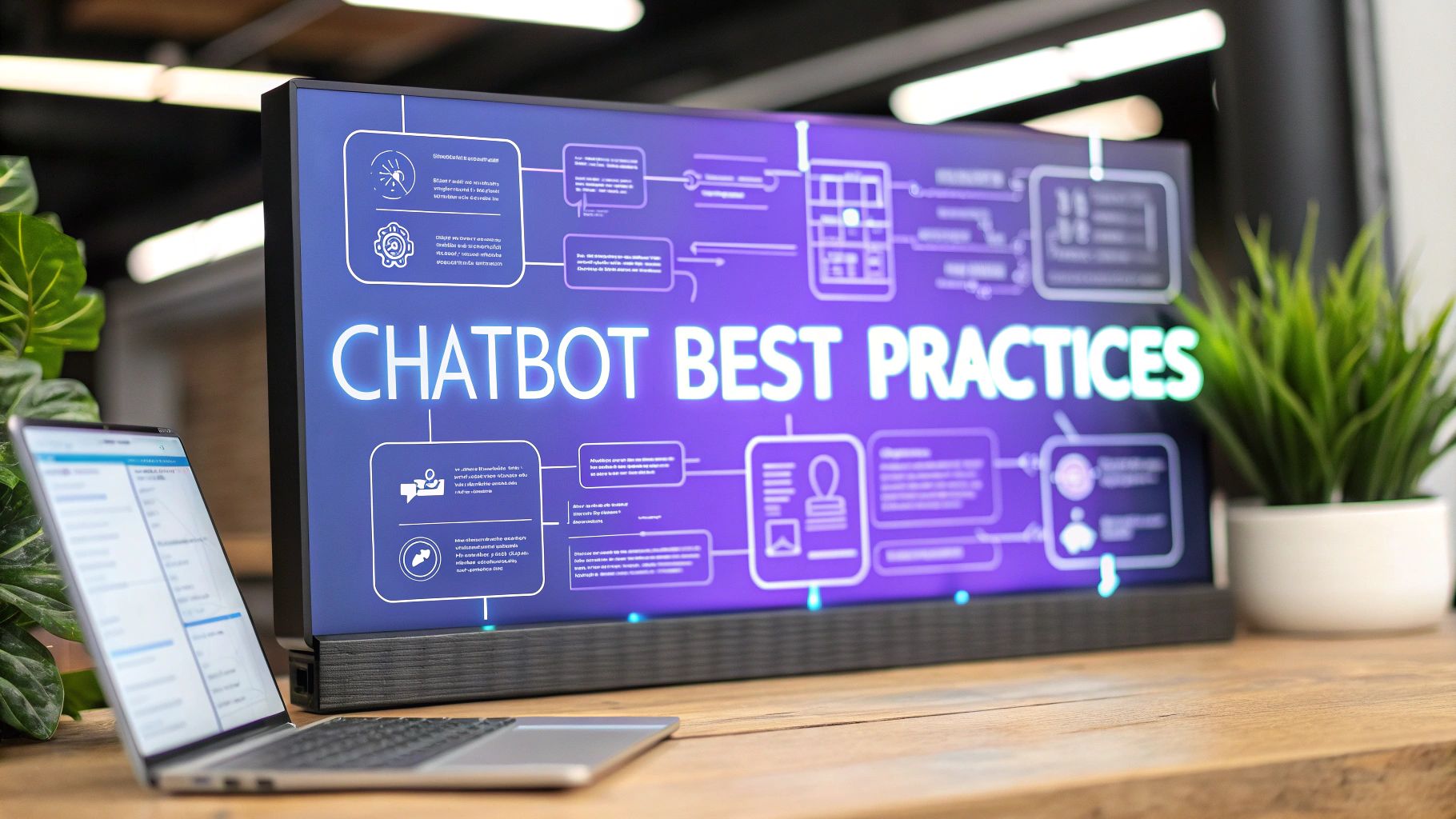
In 2025, chatbots are more than just automated responders; they are the digital frontline of your brand, capable of creating exceptional customer experiences, streamlining operations, and driving growth. However, the difference between a frustrating bot and a helpful AI agent lies in the strategy behind its creation. Simply deploying a chatbot is not enough. To truly succeed, you must adhere to a set of proven chatbot best practices that govern its design, implementation, and continuous optimization.
This guide cuts through the noise to provide an actionable framework that will transform your conversational AI from a simple tool into an indispensable asset. We will explore nine critical areas, providing step-by-step guidance on how to leverage the Chatiant platform to build a chatbot that users love, trust, and return to. Following these principles ensures your bot can handle complex interactions, reflect your brand's unique personality, and provide genuine value to every user.
You will learn to:
- Design intelligent conversational flows with precise intent recognition.
- Implement graceful error handling and effective fallback strategies.
- Maintain a consistent and engaging brand voice.
- Ensure strong security, privacy, and accessibility standards.
From crafting intuitive user onboarding to establishing comprehensive analytics for continuous improvement, these practices are the blueprint for building a high-performing AI agent. By mastering these core concepts, you can deliver tangible results, enhance user satisfaction, and secure a significant competitive advantage. Let's dive into the essential strategies for elevating your chatbot experience.
1. Design Conversational Flows with Clear Intent Recognition
The foundation of any effective chatbot is its ability to understand what a user wants and guide them to a resolution. This is where designing conversational flows with clear intent recognition becomes a critical best practice. Intent recognition is the process of training your chatbot to identify the user's underlying goal, even when it's expressed in varied or informal language. A well-designed flow anticipates user needs, correctly maps their input to a specific intent, and provides an accurate, relevant response.
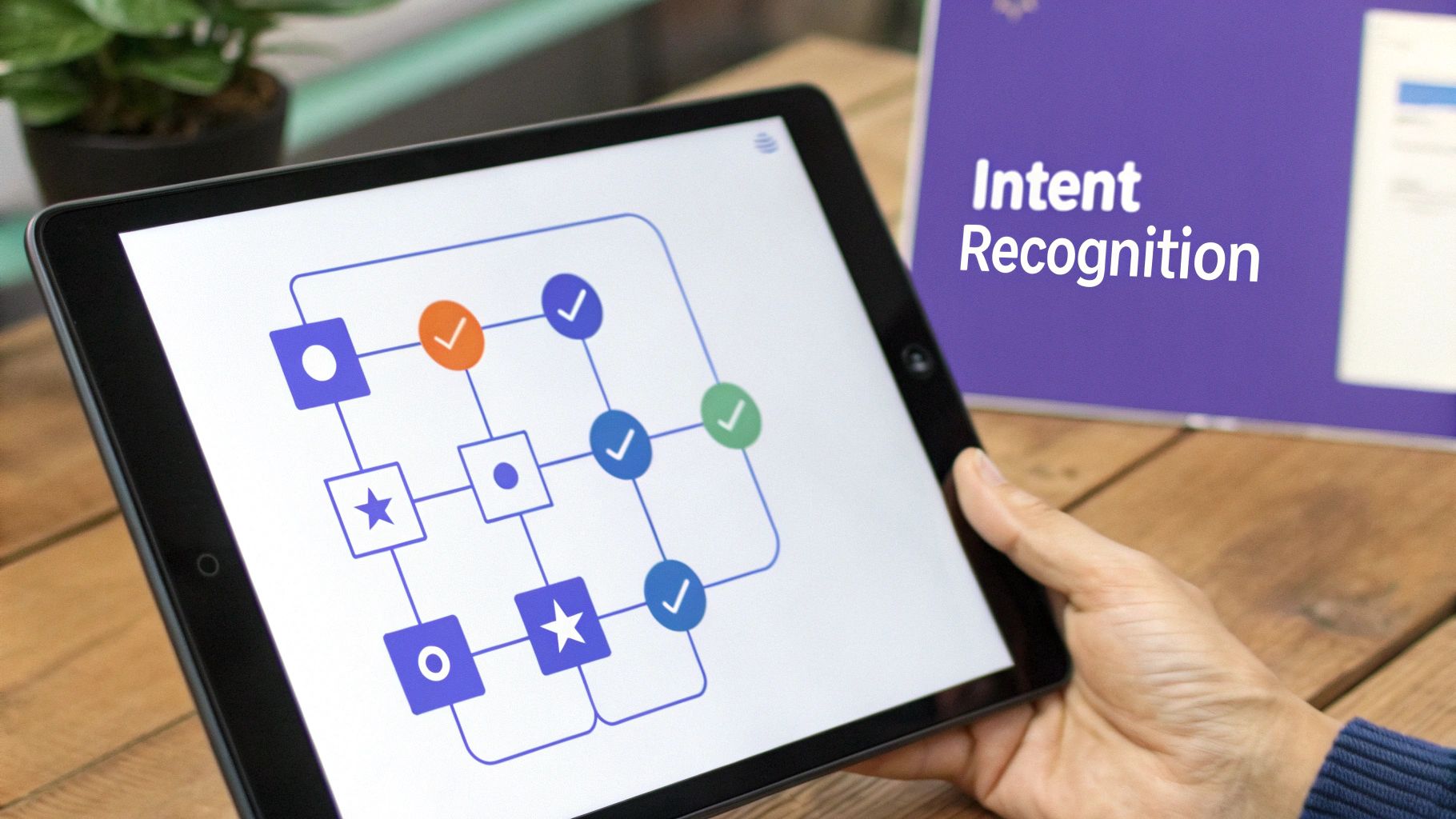
For example, a customer might type "track my stuff," "where is my order," or "package status." A chatbot with strong intent recognition understands that all these phrases correspond to a single intent: Track_Order. This allows it to trigger the correct workflow, ask for an order number, and provide the tracking information, creating a seamless user experience. Without this, the bot would fail at the first hurdle, leading to user frustration and abandonment.
Why This Is a Core Best Practice
Implementing robust intent recognition is non-negotiable because it directly impacts your chatbot's core competency and perceived intelligence. It's the difference between a bot that feels helpful and one that constantly replies with "I don't understand." By focusing on this early, you ensure your bot can handle the most common user queries efficiently, which builds user trust and boosts adoption rates.
Actionable Implementation Steps
To implement this effectively within the Chatiant platform, follow these steps:
- Map High-Value Intents First: Begin by identifying the top 5-10 reasons users contact you. These might include
Check_Order_Status,Reset_Password, orBook_Appointment. Focus on perfecting these flows before expanding. - Use Real Data for Training: Analyze support tickets, chat logs, and emails to gather real-world examples of how users phrase their requests. Use these "utterances" to train your intent models in Chatiant for higher accuracy.
- Implement Confidence Scoring: Set a confidence threshold for intent matching. If the bot's confidence score for an intent is below a certain level (e.g., 70%), design a fallback that offers suggestions or escalates to a human agent, preventing frustrating dead ends.
- Create Disambiguation Flows: For ambiguous user inputs, prompt the user for clarification. If a user says "I need help with my account," the bot could ask, "Do you want to update your details, reset your password, or view your billing history?"
By mastering intent recognition, you create a chatbot that doesn't just respond but truly understands. For a deeper dive into structuring these conversations, explore our detailed guide on how to design effective chatbot conversation flows.
2. Implement Graceful Error Handling and Fallback Strategies
Even the most sophisticated chatbot will eventually encounter a query it doesn't understand or a technical glitch. The difference between a good and a great chatbot lies in how it handles these moments. This is where implementing graceful error handling and fallback strategies becomes one of the most critical chatbot best practices. A fallback strategy ensures the conversation doesn’t hit a dead end, guiding the user toward a resolution even when the bot is confused or a system fails.
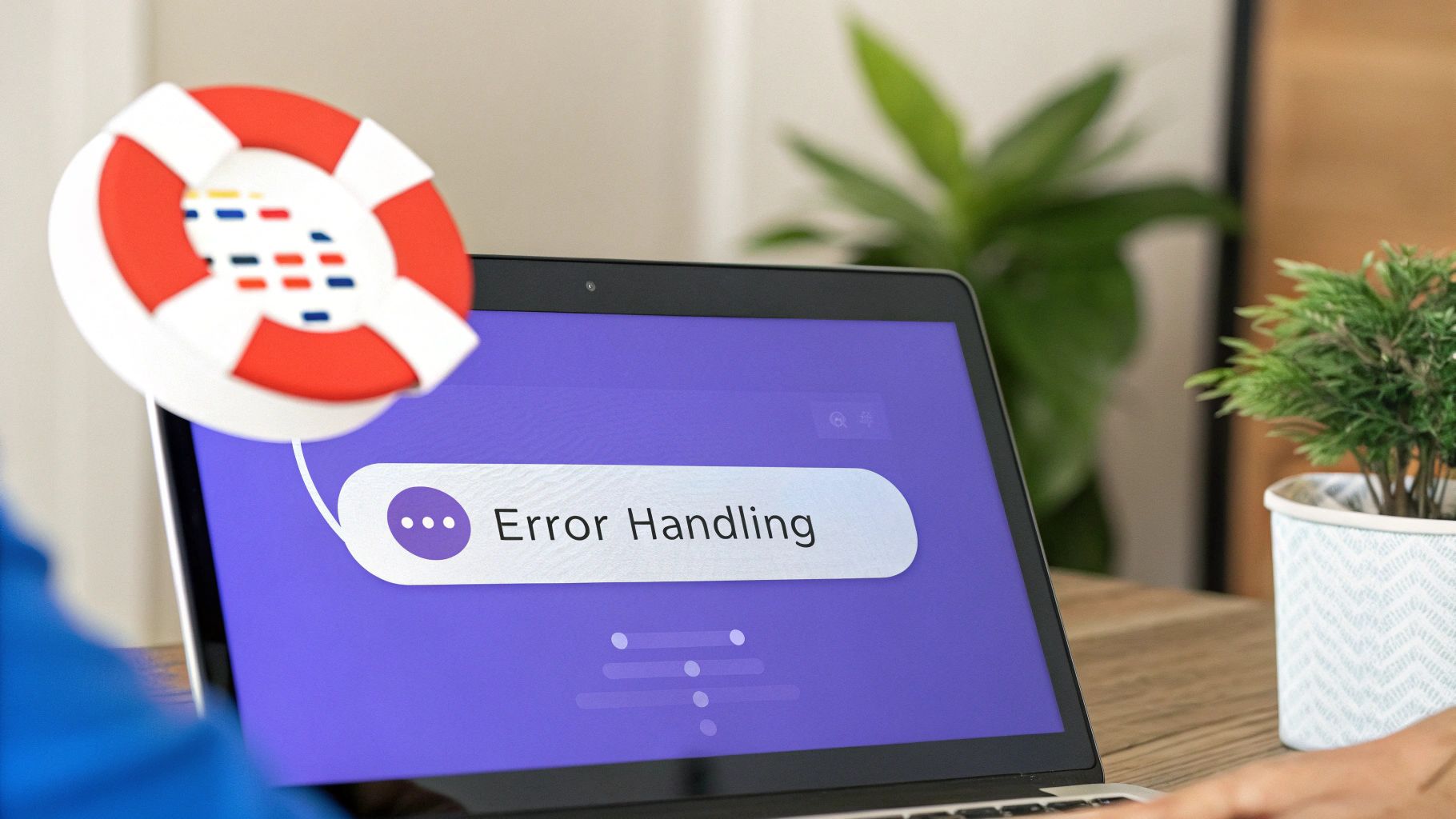
Think of Zendesk's Answer Bot, which seamlessly escalates a conversation to a human agent when it can't resolve an issue. Similarly, many bots on Facebook Messenger, when they don't understand, will respond with "Sorry, I'm not sure about that, but here are some things I can help with," followed by clickable buttons for common intents. This approach prevents user frustration by managing expectations and providing a clear path forward, turning a potential failure into a helpful, guided interaction.
Why This Is a Core Best Practice
Implementing robust error handling is fundamental because it builds resilience and maintains user trust. A chatbot that simply says "I don't understand" repeatedly will be quickly abandoned. A graceful fallback, on the other hand, shows the user that the system is designed with their experience in mind, acknowledging its limitations while still offering assistance. This practice directly reduces bounce rates and ensures that users see the bot as a reliable first point of contact, even if it sometimes needs help.
Actionable Implementation Steps
To build effective fallback strategies within the Chatiant platform, follow these steps:
- Create Tiered Fallback Responses: Don't use the same "I don't understand" message every time. On the first failure, offer suggestions. On the second, rephrase the options. On the third consecutive failure, proactively trigger an escalation to a human agent.
- Establish Clear Escalation Criteria: Define specific triggers for escalating to a live agent. This could be based on keywords like "talk to a person," a low confidence score on an intent, or a user repeatedly failing to get an answer.
- Log All Errors for Improvement: Use Chatiant's analytics to log every instance where a fallback was triggered. Regularly review these "unhandled utterances" to identify gaps in your intent training and create new conversational flows to address them.
- Provide Alternative Contact Options: When live chat isn't available, make sure your fallback message provides alternative support channels, such as a contact form, a support email address, or a link to your knowledge base.
By designing intelligent recovery paths, you create a more robust and user-friendly automated experience. To see how these principles apply in a high-stakes environment, discover how to use a chatbot for IT support.
3. Maintain Consistent Brand Voice and Personality
Beyond functionality, a great chatbot delivers an experience that feels authentic and aligned with your brand. This is where maintaining a consistent brand voice and personality becomes one of the most crucial chatbot best practices. A chatbot's personality is the combination of its tone, word choice, and communication style, which should directly reflect your company's core values. This ensures every interaction reinforces brand identity, builds trust, and makes the experience more memorable and engaging for the user.
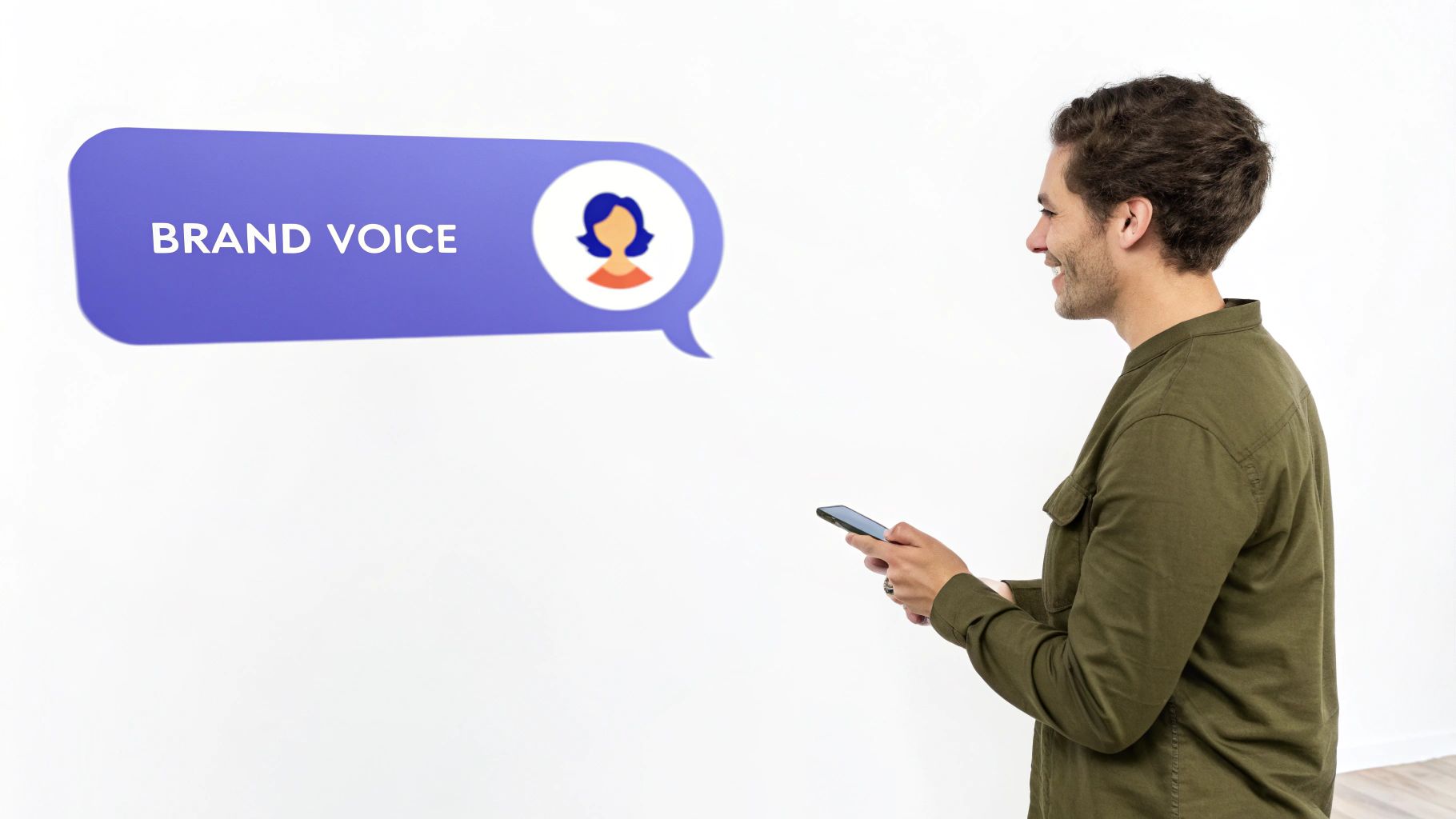
For instance, Domino's "Dom" chatbot has a friendly, fun, and pizza-obsessed persona that perfectly matches its brand. In contrast, KLM's chatbot adopts a professional yet approachable tone, embodying the reliability expected of an international airline. These bots don't just provide information; they communicate in a way that feels like a natural extension of the brand, creating a cohesive customer journey. A well-defined personality transforms a functional tool into a relatable brand ambassador.
Why This Is a Core Best Practice
Defining a distinct personality is non-negotiable because it directly influences how users perceive your brand through automated interactions. An inconsistent or generic tone can feel disjointed and robotic, undermining brand credibility. A consistent voice, however, humanizes the technology, fosters an emotional connection, and can significantly increase user satisfaction and loyalty. It turns a simple query-and-response into a positive brand touchpoint.
Actionable Implementation Steps
To implement this effectively within the Chatiant platform, follow these steps:
- Develop Personality Guidelines: Create a detailed tone and voice document for your chatbot. Define key personality traits (e.g., helpful, witty, formal), specify words to use or avoid, and establish rules for using elements like emojis or slang.
- Build a Persona-Driven Response Library: Within Chatiant, create a library of pre-written responses for common scenarios like greetings, apologies, and confirmations. Ensure each template is infused with your defined brand personality.
- Train All Stakeholders: Make sure everyone involved in creating or managing the chatbot, from developers to marketers, understands and adheres to the established voice guidelines to ensure consistency.
- Conduct Regular Audits: Periodically review chat logs to check for alignment with your brand voice. Use these insights to refine responses and correct any deviations, ensuring the personality remains consistent over time.
By carefully crafting your chatbot's personality, you create a more engaging and unified brand experience. To see how different personas can be applied, check out our guide on chatbot examples across various industries.
4. Provide Clear Onboarding and User Education
A powerful chatbot can fall flat if users don’t understand what it can do or how to interact with it. Providing clear onboarding and user education is a crucial chatbot best practice that sets expectations from the very first interaction. This involves creating an intuitive introduction that showcases the bot's core functions, limitations, and the best way to phrase requests, ensuring users feel confident and empowered rather than confused.
Effective onboarding acts as a guided tour. For instance, Slack's "Slackbot" excels at this by walking new users through key features with interactive prompts. It doesn't just list commands; it has the user perform them, solidifying their understanding. Similarly, a support bot might start a conversation by saying, "Hi! I can help you track orders, process returns, or check product availability. Just tell me what you need, like 'where is my package?'" This simple greeting immediately clarifies its purpose and provides a clear starting point.
Why This Is a Core Best Practice
Implementing clear onboarding is essential because it directly tackles user hesitation and prevents early abandonment. When users know what to expect, they are more likely to engage successfully and perceive the chatbot as a helpful tool. This initial guidance builds trust, reduces the frequency of "I don't understand" errors, and dramatically improves the overall user experience, leading to higher adoption and satisfaction rates.
Actionable Implementation Steps
To implement this effectively within the Chatiant platform, follow these steps:
- Craft a Welcome Message with a 'Capabilities' Menu: Start every new conversation with a concise welcome message that introduces the bot. Immediately follow up with quick-reply buttons outlining its main functions, such as "Track Order," "Return Item," or "Speak to Agent."
- Use Interactive Examples: Instead of just telling users what to do, guide them through it. For a booking bot, you could say, "Let's book your first appointment. What service are you looking for?" This learns-by-doing approach is far more effective.
- Provide an Accessible 'Help' Command: Ensure users can type "help" or "menu" at any point in the conversation to receive a reminder of the bot's capabilities and commands. This acts as a safety net, preventing users from getting stuck.
- Keep Onboarding Short and Focused: Avoid overwhelming users with a long list of every single feature. Highlight the top three to five most common use cases during the initial interaction to get them started quickly.
By properly educating your users, you transform your chatbot from a potentially confusing piece of technology into an intuitive and valuable assistant. To explore how this can be applied to customer lifecycles, read our guide on automating your customer onboarding process.
5. Optimize for Mobile and Multi-Platform Experiences
Today's users interact with businesses across a multitude of devices and platforms, from their smartphones while on the go to their desktops at work. A crucial chatbot best practice is to ensure your bot delivers a seamless and effective experience regardless of where the conversation takes place. Optimizing for mobile and multi-platform use means designing responsive interfaces and conversation flows that adapt intelligently to different screen sizes and channel-specific functionalities.
This approach ensures that a user starting a conversation on a website can pick it up in a mobile app or a messaging platform like WhatsApp without losing context or functionality. For instance, a chatbot on a desktop might use large, clickable cards, while its counterpart on WhatsApp would use concise text and numbered lists more suitable for a smaller screen. The goal is to make the interaction feel native and intuitive on every channel.
Why This Is a Core Best practice
Failing to optimize for a mobile-first world alienates a massive segment of your audience. A chatbot that is difficult to use on a smartphone will be quickly abandoned, leading to high bounce rates and customer frustration. By providing a consistent and high-quality experience across all platforms, you meet users where they are, enhance accessibility, and reinforce your brand's reliability. This multi-platform presence is essential for building a truly omnichannel customer support strategy.
Actionable Implementation Steps
To deploy a successful multi-platform chatbot with Chatiant, follow these guidelines:
- Design Mobile-First: Start your design process by focusing on the mobile experience, as its constraints force you to prioritize clarity and conciseness. Once the mobile flow is perfected, adapt and enhance it for larger desktop screens.
- Use Responsive Components: Leverage Chatiant's built-in responsive elements. Ensure that buttons, quick replies, and carousels automatically adjust their size and layout to fit the screen, providing an optimal viewing and interaction experience on any device.
- Leverage Native Platform Features: Customize interactions for specific channels. For example, use WhatsApp’s List Messages for presenting multiple options or Facebook Messenger’s persistent menu for easy access to key functions. This makes the bot feel more integrated and less generic.
- Test on Real Devices: Before deploying, rigorously test your chatbot on various physical devices (iOS and Android) and different platforms (web, Messenger, etc.). This helps you identify and fix layout issues or functional bugs that simulators might miss.
By embracing a multi-platform strategy, you ensure your chatbot is not just a tool but a consistent and reliable brand ambassador across every user touchpoint. To learn more about deploying across channels, read our guide on integrating with messaging platforms.
6. Implement Comprehensive Analytics and Continuous Improvement
Launching a chatbot is not the final step; it's the beginning of an ongoing optimization process. Implementing comprehensive analytics is a crucial best practice that transforms your chatbot from a static tool into a dynamic, learning asset. This involves systematically collecting performance data, analyzing user interactions, and using those insights to make iterative improvements. A data-driven approach ensures your chatbot evolves with user needs, becoming more effective and efficient over time.
Without analytics, you are essentially flying blind. You won't know which conversational flows are failing, where users are dropping off, or which new features are most requested. By tracking key metrics, you can pinpoint specific friction points and opportunities for enhancement. For instance, analyzing "unhandled intents" or messages the bot couldn't understand directly reveals gaps in its knowledge base, allowing you to train it on new topics and improve its helpfulness.
Why This Is a Core Best practice
This practice is fundamental because it provides the feedback loop necessary for sustainable success and ROI. A chatbot that doesn't improve is destined to become obsolete and frustrating for users. Continuous improvement, fueled by robust analytics, ensures your investment delivers increasing value. It helps you justify the chatbot's existence with concrete data, demonstrating its impact on key business goals like reduced support tickets, higher lead conversion rates, or improved customer satisfaction scores.
Actionable Implementation Steps
To effectively leverage analytics within the Chatiant platform, follow these steps:
- Define Key Performance Indicators (KPIs) First: Before diving into data, establish what success looks like. Key metrics could include Goal Completion Rate (GCR), Fallback Rate (how often the bot fails), User Retention, and Session Duration.
- Track Both Technical and Business Metrics: Monitor technical performance like response time and intent recognition accuracy. Simultaneously, track business-oriented metrics such as Cost Per Conversation or Lead Generation Volume to measure ROI.
- Review Conversation Transcripts Regularly: Manually review a sample of chat logs. This qualitative analysis provides context that quantitative data can't, revealing user sentiment, phrasing nuances, and unexpected use cases. Chatiant’s built-in logs make this process straightforward.
- Use A/B Testing for Optimizations: When improving a conversational flow or a specific bot message, don't guess what works best. Implement A/B tests to compare different versions and use data to determine the most effective approach for engaging users.
By embedding analytics into your operational rhythm, you ensure your chatbot remains one of the most effective chatbot best practices you can follow, delivering consistent and improving results. To learn more about measuring success, see our guide on essential chatbot metrics to track.
7. Ensure Strong Security and Privacy Protection
In an era of heightened data sensitivity, a chatbot is not just a conversational tool; it's a data processor. Ensuring strong security and privacy protection is a fundamental chatbot best practice that safeguards user trust and ensures regulatory compliance. This involves implementing robust measures to protect user data, maintain conversation privacy, and secure the entire chatbot ecosystem from vulnerabilities. A secure chatbot respects user privacy by design, building confidence and encouraging honest interaction.

Consider how platforms like Microsoft's Azure Bot Service provide enterprise-grade security features or how Apple prioritizes on-device processing for Siri to minimize data exposure. These industry leaders demonstrate that security isn't an afterthought but a core component of the user experience. When a user shares personal information like an email address, order number, or health concern, they are placing immense trust in your system's ability to protect it.
Why This Is a Core Best Practice
Neglecting security can have catastrophic consequences, including data breaches, loss of customer trust, significant financial penalties, and irreparable brand damage. A single security incident can undermine all the effort you've put into creating a helpful and intelligent chatbot. By prioritizing security and privacy from day one, you build a resilient and trustworthy platform that users feel safe interacting with, which is non-negotiable for long-term success.
Actionable Implementation Steps
To build a secure foundation for your bot within the Chatiant platform, focus on these critical steps:
- Adopt Privacy by Design: Build privacy directly into your chatbot's architecture. Collect only the minimum data necessary for a task (data minimization) and be transparent with users about what you collect and why via a clear, accessible privacy policy.
- Enforce End-to-End Encryption: Ensure all data, whether in transit between the user and the bot or at rest in your database, is fully encrypted. Chatiant's infrastructure supports modern encryption standards to protect sensitive conversation logs and user data.
- Implement Strict Access Controls: Use role-based access control (RBAC) to limit who within your organization can view conversation data or access the chatbot's backend. Ensure that team members can only access the data necessary to perform their jobs.
- Conduct Regular Security Audits: Proactively scan for vulnerabilities in your chatbot's code and its integrations. Stay updated on privacy regulations like GDPR and CCPA and ensure your bot's data handling practices remain compliant.
By embedding these security measures, you create a chatbot that is not only smart and helpful but also safe and reliable. To learn more about securing your conversational AI, review our guide on enterprise chatbot security standards.
8. Design for Accessibility and Inclusivity
A truly effective chatbot serves every user, regardless of their abilities or background. Designing for accessibility and inclusivity ensures your chatbot is usable by people with disabilities and from diverse cultural contexts. This best practice involves integrating features that support assistive technologies, like screen readers, and crafting conversational flows that are clear, simple, and culturally considerate, making your digital assistant a tool for everyone.
For instance, a chatbot designed with accessibility in mind will have high-contrast text and support keyboard navigation for users with motor impairments. For visually impaired users, it will be compatible with screen readers like Apple's VoiceOver, announcing messages and options clearly. An inclusive design also considers linguistic and cultural nuances, avoiding jargon or idioms that may not translate well, thereby creating a welcoming experience for a global audience.
Why This Is a Core Best practice
Prioritizing accessibility and inclusivity is not just a matter of compliance or social responsibility; it is a strategic business decision. An accessible chatbot expands your potential user base to include the millions of people living with disabilities. It enhances your brand's reputation as an ethical and user-centric organization. Failing to do so excludes a significant portion of the population and can lead to legal risks under regulations like the Americans with Disabilities Act (ADA) and a poor user experience for many.
Actionable Implementation Steps
To implement this effectively within the Chatiant platform, follow these steps:
- Follow WCAG Guidelines: Adhere to the Web Content Accessibility Guidelines (WCAG) for your chatbot's web interface. This includes ensuring sufficient color contrast, providing text alternatives for non-text content, and making all functionality available from a keyboard.
- Test with Assistive Technologies: Regularly test your chatbot using common assistive tools like screen readers (e.g., NVDA, JAWS, VoiceOver) and voice command software. This helps identify and fix barriers that prevent some users from interacting with your bot.
- Provide Alternative Interaction Methods: Offer multiple ways for users to provide information. For example, in addition to typing, allow users to select options from buttons or carousels. For complex tasks, ensure there is an easy and clearly marked path to escalate to a human agent.
- Design Inclusive Conversations: Write clear, simple copy. Avoid complex sentence structures, slang, or culturally specific metaphors. When deploying globally, ensure your content is localized properly, not just translated, to respect cultural contexts and norms.
By building accessibility and inclusivity into your chatbot's foundation, you create an experience that is not only compliant but genuinely helpful and respectful to all users. To learn more about building ethical AI, you can explore resources from pioneers like Microsoft's Responsible AI principles.
9. Establish Clear Boundaries and Set Appropriate Expectations
One of the most effective chatbot best practices for building user trust is managing expectations from the very first interaction. This involves being transparent about your chatbot’s identity and clearly communicating what it can and cannot do. When users understand a bot's scope and limitations, they are less likely to ask out-of-scope questions, which prevents frustration and creates a more positive, predictable experience.
For instance, a user interacting with a banking bot should know upfront if it can only check balances and transaction history but cannot process a loan application. Leaders in this space, like OpenAI with ChatGPT, often include disclaimers about potential inaccuracies and explicitly state they are interacting with an AI. This simple act of setting expectations frames the entire conversation for success, guiding users toward productive interactions and away from dead ends.
Why This Is a Core Best Practice
Establishing clear boundaries is crucial because it directly prevents user frustration and builds a foundation of trust through honesty. An unmanaged expectation is a guaranteed source of disappointment. When a chatbot overpromises and underdelivers, users lose confidence not only in the bot but also in the brand behind it. By being upfront about the bot's capabilities, you empower users to engage effectively and appreciate the value it can provide, rather than focusing on what it can't.
Actionable Implementation Steps
To implement this effectively within the Chatiant platform, follow these steps:
- Create a Clear Welcome Message: Start every conversation with a concise greeting that identifies the chatbot as a virtual assistant and briefly outlines its main functions. For example: "Hi! I'm Chatiant's support bot. I can help you track orders, process returns, or answer FAQs. How can I help?"
- Be Upfront About Limitations: Don't be afraid to state what the bot can't do. If a user asks a question outside its scope, design a response that says, "I can't help with that just yet, but I can connect you to a human agent who can." This provides a helpful next step instead of a failure.
- Provide Guided "Help" Menus: Include a persistent "Help" or "Main Menu" option that users can access at any time. This menu should clearly list the chatbot's core capabilities, serving as a constant reminder of how it can be used successfully.
- Set Realistic Accuracy Expectations: Especially for generative AI bots, it’s wise to include a subtle disclaimer like, "I'm still learning, so please double-check critical information." This prepares users for the possibility of minor errors and encourages responsible use.
By clearly defining your chatbot's role, you create a more transparent and effective user experience. For more guidance on crafting these crucial initial messages, see our post on writing effective chatbot welcome messages.
Chatbot Best Practices Comparison
From Best Practices to Business Impact with Chatiant
We've journeyed through the nine essential pillars of chatbot development, from the initial architecture of conversational flows to the ethical considerations of accessibility and privacy. Adopting these chatbot best practices is not merely a technical exercise; it's a strategic imperative that transforms a simple automated tool into a powerful engine for business growth, customer loyalty, and operational efficiency. Moving beyond generic advice, we’ve explored the nuanced, actionable steps required to build a chatbot that truly understands, helps, and engages users.
Let's recap the foundational principles that distinguish an exceptional chatbot from an average one. It all begins with a deep commitment to the user experience. This means designing with clear intent recognition, ensuring every conversation starts on the right foot, and implementing graceful fallback strategies for when things inevitably go off-script. A consistent brand voice and clear user onboarding are not just aesthetic choices; they are crucial for building trust and setting the stage for a productive interaction.
Turning Theory into Tangible Results
The true value of these principles is realized when they are put into practice consistently. For operations and customer success teams, this means creating an experience that feels seamless and intuitive, whether the user is on a desktop browser or a mobile device. For developers and designers, it requires a meticulous approach to security, ensuring user data is protected, and a conscious effort to build for inclusivity, making sure your chatbot is usable by everyone.
The journey doesn't end at launch. The most impactful chatbots are those that evolve. By implementing comprehensive analytics, you turn every user interaction into a learning opportunity. This continuous improvement loop, fueled by real data, is what separates a static, underperforming bot from a dynamic, high-value asset. It’s the key to refining conversation flows, understanding user pain points, and ultimately, delivering more value. Setting clear boundaries and managing user expectations ties everything together, preventing frustration and fostering a more positive perception of your automated assistant.
Your Roadmap to Conversational AI Excellence
Mastering these chatbot best practices is the definitive roadmap to unlocking the full potential of conversational AI. It's about shifting your perspective from seeing a chatbot as a cost-saving measure to viewing it as a strategic investment in your brand's relationship with its audience. When implemented correctly, a well-designed chatbot can:
- Elevate Customer Satisfaction: Provide instant, 24/7 support that resolves queries efficiently and accurately.
- Increase Conversions: Guide users through sales funnels, answer product questions, and proactively engage potential leads.
- Boost Operational Efficiency: Automate repetitive tasks, freeing up your human agents to focus on complex, high-value interactions.
- Build Brand Loyalty: Deliver a consistent, helpful, and personable brand experience with every conversation.
These outcomes are not just theoretical possibilities; they are the direct results of a disciplined, user-centric approach to chatbot design and optimization. By focusing on these core tenets, you are building more than just a bot; you are architecting a better customer journey, a more efficient operational workflow, and a stronger, more resilient brand. The path forward is clear: integrate these practices, measure your results, and iterate relentlessly. This is how you move from a functional chatbot to a transformational business tool.
Ready to put these advanced chatbot best practices into action with a platform built for excellence? Chatiant enables you to create a powerful AI assistant trained on your own data and deploy it seamlessly across your website and internal tools. Start your journey today and build a smarter chatbot that drives real business impact. Visit Chatiant to learn more.


